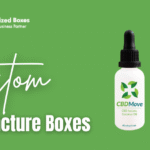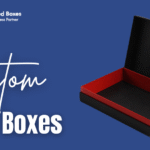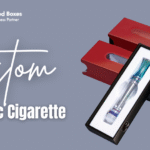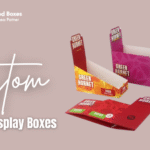When developing the product’s packaging, users may have encountered the phrases embossing vs debossing and questioned the difference.
Stamping elevates your artwork (often your logo) over your package’s printed material, whilst debossing lowers the painting to give it a sunken impression.
A cocktail napkin has been imprinted with the company’s emblem, which is slightly lifted from the napkin’s foundation. A silicone wristband with the brand imprinted is etched laser merchandise.
For many goods, such as napkins and wristbands, the decision of emboss vs deboss is obvious. However, when it comes to bespoke packaging, the decision between impressing and foiling is influenced by several elements.
The effect of embossing is similar. It (and its inverse, debossing) are two processes for impressing or depressing an image into paper. These trendy print effects are fantastic for giving your print item a modern look. When paired with additional products, such as foil stamping, embossed patterns may elevate an excellent piece to a premium one.
To emboss vs deboss? They are both methods for imprinting impressed or depressed pictures onto paper, which may lend a special touch to your print works.
Which should you choose for your project? It all comes down to personal preference. Let’s look more closely at the distinctions between embossing vs debossing.
Emboss Vs Deboss: What’s The Distinction?
Like silk screening, laser engraving, or pad printing, stamping and foiling are imprinting processes. You’ve undoubtedly heard you emboss and foil phrases if you want to create promotional goods with your logo, slogan, or text. You may be wondering. What about heads or tails? Who’s in charge? “Does it matter, and should I be concerned?” We have answers!
Both these approaches perform an excellent job of imprinting your brand on a product so that it does not fade or wear off. However, word geeks and information freaked you. If you’re reading, all these use a little more detail. Onward and upward!
-
Basics of these two strategies
Metal plates are in both procedures to press or imprint your design onto the goods you’re modifying. Stamping produces a design that is elevated above the surrounding material, whereas other produces a design that is pressed into or sunk into the surrounding medium.
What Is Embossing?
A commercial printing firm employs two significant elements to emboss: a die, a customized metal plate cut into the picture customers wish to foil stamping, and stock (paper). The die, like a stamp, pushes into the store, gently raising pictures of the composition of any print piece.
A single-level die elevates the image to a consistent height or depth, whereas a multi-level die makes a more intricate emboss vs deboss complex.
The result is a three-dimensional appearance highlighting a specific design section. People frequently imprint a corporate logo, bespoke image, initials, or a pattern for a premium impression.
Most people associate imprinting with raised effects on paper, such as business cards, greeting cards, and invitations. However, embossing may be done on various other materials, including metal, acrylic, leather, wood, and linen. However, we’ll focus on embossing on paper packaging products, integrating stamping with other effects, and prepping your design for the most remarkable outcomes.
What is Deboss Printing?
Debossing is the polar opposite of everything said above. When an image, logo, or text is imprinted into your print piece to create a depressed effect – an indentation in the stock you’re using – it’s called a depressed look.
To create the depressed focus region, the front of the paper or card material is imprinted with the metal die. The main difference between the two procedures, aside from the fact that one is rising and the other is flat, is that debossing does not conflict with the opposite side of your stock.
As a result, it provides you with both sides to work with, while embossing does not. Additionally, similar to the imprinted print process, you can fill the debossed region with ink or foil stamping or leave it empty.
Benefits of Embossing
- It creates a 3D pattern that is visible from the surface.
- Applying foil stamping to an embossed pattern is more straightforward.
- Can accommodate more precise detail than debossing
- Better for individualized paper items like business cards and stationery.
Benefits of Debossing
- Gives the spatial design depth
- Applying ink to a foiling pattern is more superficial.
- Its print does not affect the material’s reverse.
- Such plates and dies are often less expensive than stamped ones.
- Better for bespoke baggage tags, wallets, padfolios, briefcases, and other leather items
Emblazoning Your Logo into Product Packaging: The Process
A metal plate, as well as a die, is made before the embossing process begins. Users wish to emboss the raised graphic onto the finished product with the submitted pictures.
The product under this plate is forced against it, causing the product design (such as the packaging) to stand out. Then, this procedure is carried out repeatedly. Stamping dies are suitable for both small- and large-scale projects since they are made of metal, making them highly sturdy.
It’s important to remember that impressing a brand into a product differs from raised ink printing (also known as thermography). Instead of elevating the paper and altering its shape, it is accomplished by employing a specific kind of powder that binds to the paper when heated.
The quality of embossed, which gives a final packaging design a touch of elegance and exquisite style, is undeniable even though it frequently has a higher setup cost.
The Technique for Debossing your Logo on Product Packaging
Like embossed, other applies the logo from the top down rather than pressing the die below the goods to make it stand out. The logo is recessed into the item as a result. It has a distinctive appearance while not being as popular as embossing.
Emboss vs Deboss & its Materials
For embossing and debossing, several materials can be used.
-
Paper
Paper is a typical material for posters and business heading paper.
-
Cardstock
It is ideal for making beautiful invitations or high-quality, professional business cards.
-
Metal
With the aid of metal embossed, your company’s signage may genuinely stand out from the crowd. You can even customize jewelry or keychains to make the ideal, unique present.
-
Fabric
An innovative and striking approach to adorning t-shirts or other clothing or linen articles is embossing or debossing them. However, keep in mind that not all textiles can withstand heat effectively.
-
Leather
Luggage tags, wallets, diaries, notebooks, and laptop bags are all made of leather. Stamping or foiling leather items may provide a personal touch, making them ideal for luxury presents or promoting your brand.
-
Plastic
Many ordinary plastic goods, such as loyalty cards, memberships, and bank cards, have been embossed. Keep in mind that heat and pressure used in stamping and foiling may not always work with plastic.
Considerations for Emboss Vs Deboss
Not all pictures emboss well, so it’s worth investing extra money and effort upfront in getting your job done well. Here are some things to think about before embossing a portion of your printed artwork.
- Begin with vector art: Request that your designer sends the final design as a vector art file rather than a raster file. These files will transfer the best into an embossing die since vector art comprises mathematical rules that allow it to be scaled up or down without losing quality.
- Select the perfect area of your design for stamping: The ideal graphics to imprint include text, logos, a single picture, initials, and a little pattern or ornamentation. While there are no hard-and-fast rules, an emboss or deboss looks better when used as an accent rather than a complete item.
One instance was stamping a repetitive feature on the whole side of an item adds style as a repeating pattern on the cover of a tiny printed piece like an invitation or business card.
- Make simple art: Emboss appears best when applied to detailed artwork since it gives a 2D picture literal three dimensions. So, keep it basic. Artwork tinted, colored, or otherwise made to resemble 3D may appear distorted when stamped.
- The greatest portions of the pattern should be embossed in the deepest places if there are many levels: The paper is more prone to rip if you imprint a very small portion of your design too deeply. Keep your deep embossing to your artwork’s major portions.
- If at all feasible, choose a thicker paper stock: The best-embossed items emphasize the depth and richness of the embossed designs or pictures using a detailed die and thicker paper material.
- Think about: How the embossing will affect the design on the reverse of your print piece. It turns to stamp into a chance to add some genuinely excellent images to your project rather than a constraint.
While embossing or debossing uses, printed materials stand out when others don’t. They are the business cards that people keep running their fingers over, or the elegant wedding invites that capture a particular day.
Even if the price is a little higher than a typical print job, it’s worthwhile when the print materials achieve their intended goal of creating lasting impressions that draw attention to business.
What Makes Embossed Cost More Than Debossed?
You might ask why stamping is frequently more expensive if both techniques employ metal plates to push the design into the material.
In reality, embossing requires a separate metal component, called a “counter,” in the printing business. To press the die into the material, this is necessary.
If you require a small run of printed products, it might not be financially advantageous to add that upfront expense to your printing project because the usage of the counter raises the setup cost.
It’s also conceivable that this procedure may cost more if you have specific requirements for your imprinting, such as a deep depression in the packaging or an enclosed box that will later be stamped with your logo. In this situation, hand debossing can be necessary to get the high-quality output you need and better outcomes.
Which Technique Should You Use, Emboss Vs Deboss?
Designers know that a seemingly straightforward issue, such as understanding the distinction between stamping and foiling, might have a convoluted solution, but that doesn’t mean you have to work it out on your own.
Learn more about our thorough packaging services by requesting a free estimate immediately. You’ll also discover why so many businesses, big and small, depend on the best companies to make their packaging dreams a reality.
Conclusion
They are nearly identical (simply stamped paper), but the variation is in the position of the engraving. Both are made by stamping the piece with metal plates. Debossing is stamping the paper on the front to make the image, text, or design indent. It creates a depression below or away from the show. Embossing is stamping words, images, or graphics from the back of a metal plate. The visuals are raised or elevated as a result of this.







